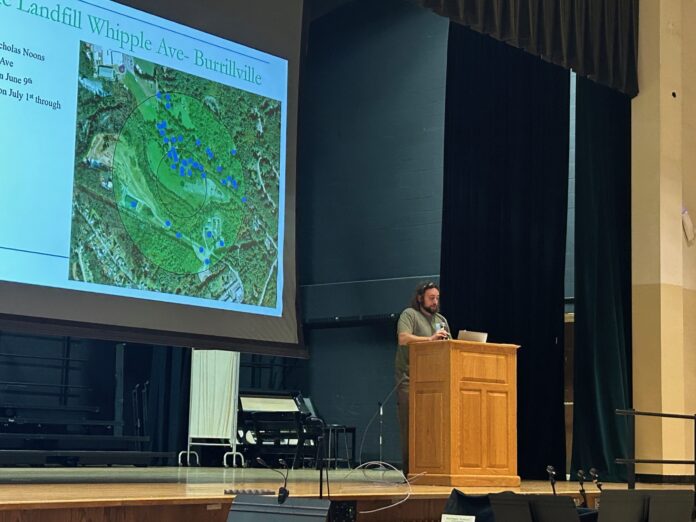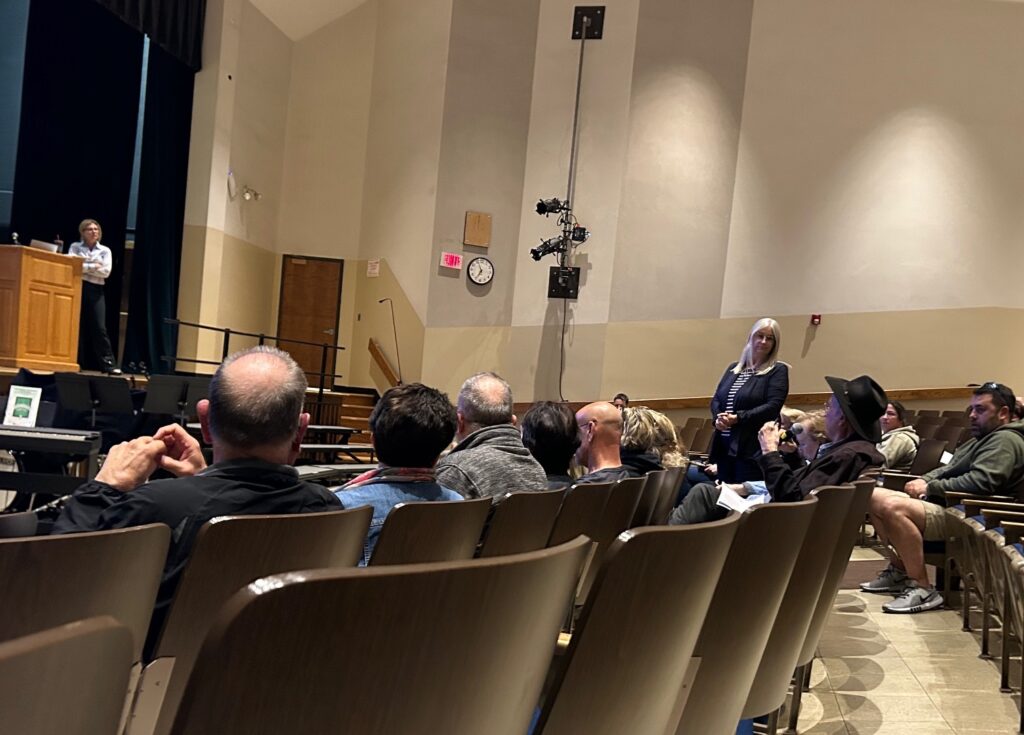
NORTH SMITHFIELD – Homeowners with private wells in targeted neighborhoods in Glocester, Burrillville and North Smithfield will have access to free water testing to screen for PFAS and if needed, funding for remediation through a new state-administered grant program that aims to address the toxic chemicals.
The Rhode Island Department of Environmental Management has begun notifying those who qualify with properties within a quarter mile of the Whipple Avenue landfill in Burrillville, the Harmony Fire Station on Putnam Pike in Glocester, and the Primrose Fire Station in North Smithfield.
Community outreach efforts now underway included a joint meeting with officials from the Rhode Island Department of Health and the Rhode Island Department of Environmental Management at North Smithfield High School Monday night.
“They’re a concern because they cause health problems,” explained Ann Battersby, an environmental scientist and enforcement manager for RIDOH. “We regulate them in Rhode Island through a state law.”
Known as forever chemicals, Battersby noted that PFAS, or or per- and polyfluoroalkyl substances, include a large group of manmade chemicals originating back to 1940s and used in consumer products such as fast food packaging and cosmetics. Health problems associated with exposure include everything from higher cholesterol, to an increased risk of cancer and a weakened immune system.
“They don’t break down,” explained Battersby. “They were designed that way. It seems to be that we’re finding it ubiquitously in our environment.”
Laws passed in recent years aim to address the six most commonly found in the state, and mandatory water testing began in 2022 with samples from some 474 public water systems in Rhode Island. Systems discovered to have PFAS levels exceeding the standard of 20 parts-per-trillion – such as the wells serving North Smithfield High School and Middle School – had to develop remediation plans.
“I think we’re doing a really good job in Rhode Island,” Battersby said, noting that new federal regulations will also soon come in to play. “Rhode Island will adopt the EPAs rules.”
RIDEM has secured $9.4 million in funding from the EPA this year to begin to address private wells, and is now collecting voluntary samples from properties within a quarter mile of sites throughout the state deemed “high priority,” – with known or suspected PFAS sources and no access to a public water supply. The sites include fire stations, as firefighting foam previously contained a high level of PFAS, and former landfills, where testing has consistently shown levels exceeding the standard.
At the Primrose Fire Station on Providence Pike, testing was completed independently after several firefighters reportedly experienced health issues, and showed PFAS levels of 70 ppt. Letters notifying qualifying residents of the opportunity for free testing in that area were sent out on Monday, May 5, with sampling to be completed by the end of the month.
“The reason this one came on as priority is the fire station itself decided to do a sampling,” said RIDOH Environmental Engineer Nicholas Noons.
Noons noted that PFAS can get into the bedrock and travel from the site, affecting other private wells.
“It’s just the nature of these chemicals,” said Noons. “It doesn’t take much to cause a problem.”
In northern Rhode Island, similar notices went out to the owners of homes with private wells by the Harmony Fire Station, with letters sent to qualifying residents on Wednesday, April 30. Those eligible by the landfill in Burrillville are expected to receive letters in early June, with sampling scheduled to take place in July.
Of PFAS at former waste disposal sites, Noons said, “We have yet to find one that’s not a problem.”
Homeowners in the target areas who participate and discover beyond standard levels of the contaminants will receive help with remediation. If several homes in a particular area show high levels, additional properties could be added to the list.
The group noted that the targeted approach aims to address areas of most concern, and could be expanded in future years.
The meeting included a question and answer session, and those in attendance sought information ranging from the cost of testing, to ways to reduce PFAS in their water. Noons noted that reverse osmosis can be an effective, but boiling is unlikely to help.
“Boiling water actually makes things worse for some contaminants,” said Noons.

Often, point-of-entry systems are installed.
Battersby emphasized the need to use a certified laboratory for all testing.
“You can not test your drinking water through an at home test,” she said. “They do not work.”
Resident Beth Newberry asked why artificial turf fields were not among the list of targeted sites.
“We haven’t looked at those directly yet because they’re not as prevalent,” said Noons, adding that the state legislature recently signed a law that will ban the use of PFAS in such products sold in Rhode Island, and that replacement of turf fields could be an issue in the future, as the materials may no longer be for sale.
The agency officials outlined information available for homeowners outside the target zones who are concerned about contaminants. Battersby noted that deeper wells are generally at less of a risk, while dug wells are more likely to run dry and see potential contamination.
“It’s really up to the homeowner to maintain their well,” she said.
For homeowners seeking information about wells built after 1972, she said that RIDOH may have completion reports on file.
Battersby recommended that all private well owners should be testing annually for things like bacteria, and every 3 to 6 years for metals and corrosion. Testing for manmade chemicals such as PFAS, she said, should be completed every 5 to 10 years.
A list of certified labs can be found here and more information from RIDOH on water testing is located here.
General information from RIDOH on PFAS can be found here.









PFAS, what a disaster we have in our hands. Nowhere will be safe before long?
There is definately a lot to find out about this subject. I like all the points you made